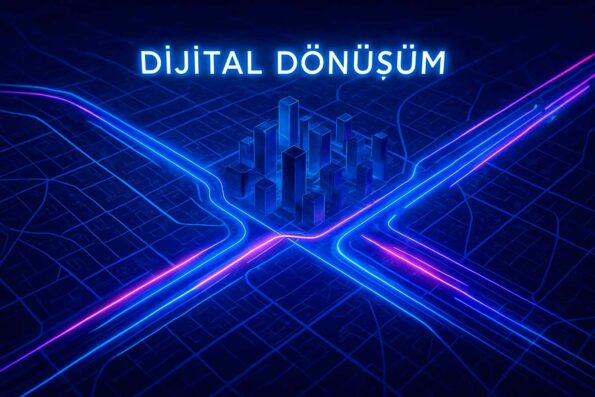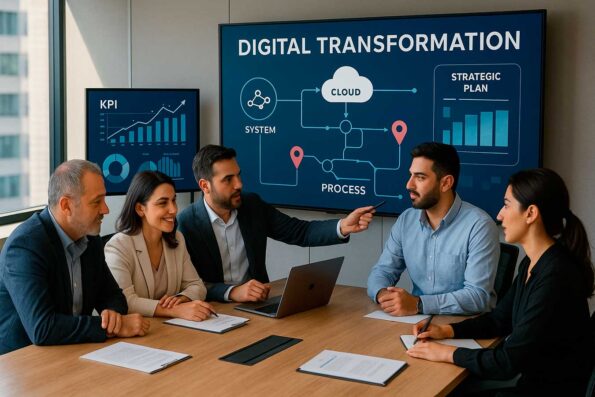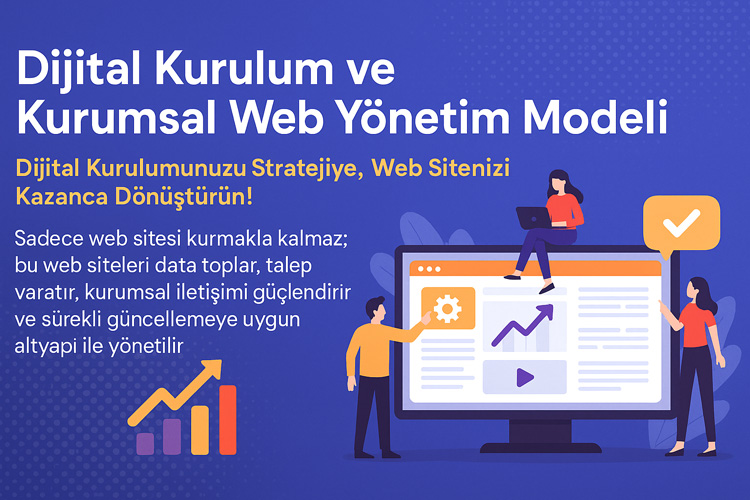Technology Transformation Map: In the age of digitalization, falling one step behind every day can mean falling out of competition. Many companies trying to move forward with traditional methods face problems like inefficiency, human error, slow decision-making, and low customer satisfaction. But is technological transformation enough to eliminate these risks? No. The important thing is to implement the transformation not haphazardly, but with a structured and strategic plan. This is precisely where the technology transformation map comes into play. 🚨
Many businesses begin their transformation process with enthusiasm; however, when they proceed without a clear path, they either get stuck halfway through or waste their resources. When questions like when to implement which technology, and to whom and how to transfer the digitalization process remain unanswered, the transformation turns into complexity. This situation brings not only technological chaos but also cultural chaos. This is why a roadmap is essential.
In this guide, we will detail the steps that will both meet your company’s current needs and prepare it for the future. A technology transformation map is not only a planning tool; it is also a strategic compass your business must follow for sustainable success. 🌍 It’s time to take conscious, result-oriented steps instead of haphazard digital investments.

İçindekiler
Toggle🧭 What is a Technology Transformation Map and Why Is It Necessary?
The vast majority of companies embarking on a digital transformation process begin without fully understanding what they need or where to begin. As a result, a large portion of technological investments turn into either short-term inefficiencies or long-term wasted budgets. But have you ever considered that every company should have its own unique roadmap? That’s where the technology transformation map comes in. This map isn’t just a plan; it’s a compass that defines all the steps, priorities, and strategic goals a business should follow on its digital journey. 📍
This map clarifies questions like which technology your company will integrate and when, which business processes will be digitized, and how employee onboarding will be managed. A Technology Transformation Map ensures not only the establishment of the technological infrastructure but also its sustainable operation. This way, digital transformation becomes a shared strategy not only for the IT department but for the entire organization. 🚀 This map helps define critical decisions in advance, such as which software to deploy and when for which team. The result: Lower costs, higher productivity, and happier teams.
🔍 What Does a Technology Transformation Map Mean?
A technology transformation map is a comprehensive guide that maps a company’s digitalization journey step by step, tying each technological step to business goals. This map doesn’t just include technical details; it also covers cultural transformation, employee training, and operational alignment. For example, if an ERP system is to be transitioned, it also identifies which business units need to be ready before the system is implemented. ✅
Adapte Dijital’in 10 yıllık deneyimiyle geliştirilen bu model, kurumsal web sitenizi sadece tasarlamakla kalmaz;
onu data toplayan, talep yaratan, kurumsal iletişim sağlayan bir dijital yönetim altyapısına dönüştürür.
Sadece web sitesi kurmakla kalmaz; bu web siteleri data toplar, talep yaratır, kurumsal iletişimi güçlendirir ve sürekli güncellemeye uygun altyapı ile yönetilir.
Highlights:
- Which digital tools will be deployed and in what order?
- Which processes will be automated?
- How will the impact of the change be communicated to employees?
📌 In conclusion, the transformation process should not be considered simply as “buying software,” but as establishing a strategic structure.
🧭 Why Does Digitalization Without a Map Fail?
Unplanned digitalization efforts often lead to incompatible systems, repetitive work processes, and employee resistance. Because most companies proceed without creating a map when investing in the transformation process, they oftenGood encounters problems such as buying twice and experiencing integration problems between systems. 📉
Examples of sectors experiencing problems:
- In the manufacturing sector, machines cannot generate data due to lack of integration.
- In the service sector, CRM systems are not used by employees.
- E-commerce companies work with fragmented data across different platforms.
🎯 The solution is to create a clear digital roadmap from start to finish. “Technology Transformation Map”
🧩 Who Needs a Transformation Map?
Companies of all sizes should create a technology transformation map. For SMEs, this map is critical for preventing resource waste and choosing the right tools. For large companies: It is indispensable for managing hundreds of employees, multiple departments and complex infrastructure. 🤖
Who needs it and why?
- Startups: Choosing the right technology in the MVP process
- SMEs: Maximum efficiency with a low budget
- Corporate: Process compliance and human resource management
- Public institutions: Security, transparency, and performance
📍 Whether you’re small or large, the Technology Transformation Map moves you from clutter to clarity.
Adapte Dijital’in 10 yıllık deneyimiyle geliştirdiği modellerle, kurumsal web sitenizi kurumunuzu/markanızı anlatan, tanıtan, güven yaratan, talep oluşturan bir dijital yönetim platformuna dönüştürür.
Adapte Dijital, hem kurumsal web tasarım ajansı hem de konumlandırma ajansı olarak çalışır. Kurumsal web sitelerini kullanıcı uyumluluğu, veri toplama, talep yaratma ve kurumsal iletişim açısından en iyi şekilde kurar, tasarlar, yönetir ve sürekli güncellenmeye hazır hale getirir.
🔐 What is the Risk of Digital Investment Without a Map?
Digital investments are often costly, and poor choices can lead to long-term damage. In a company operating without a map, a vehicle is purchased but not used, software is purchased but not trained, and a system is installed but data is not generated. This hinders the return on investment. 💸
Risky situations:
- ERP is purchased, but processes are not compatible
- CRM system is available, but sales team is not using it
- Website is available, but data is not collected
- Automation is available, but business processes are still manual
🔍 Therefore, before every investment, a Technology Transformation Map should be designed, and this map should be perfectly aligned with the business objectives.
How to Determine Your Company’s Digital Maturity Level?
Before drawing a Technology Transformation Map, it’s essential to know where you stand. So, where is your company in terms of digitalization? Any step taken without answering this question will either fall short or backfire. Many companies consider themselves “digitalized” simply because they have a few digital tools. However, this is merely an illusion. True digital maturity is about integrating technology, extracting meaning from data, automating processes, and preparing human resources for this transformation. 🧩
The digital maturity level that comes into play at this stage serves as a mirror for you. This analysis, which examines every aspect from operational competence to cultural transformation, clarifies where you should begin your transformation. If your digital maturity is low, you should first establish the basic technological infrastructure; if it’s high, you should focus on optimizing processes. A transformation undertaken with this awareness saves time, prevents budget waste, and unlocks the company’s true potential. 🚀
What Does Digital Maturity Mean?
Digital maturity refers to a business’s level of technology integration, strategic awareness, and openness to a digital culture. This concept focuses not only on system ownership but also on the correct use of these systems and the ability to make data-driven decisions. For example, digital maturity isn’t demonstrated by purchasing CRM software, but by effectively using it to improve the customer experience.
🔍 Maturity levels are generally divided into the following stages:
- Starting: Paper and pen, Excel, etc.
- Evolving: Piecemeal digital solutions
- Integrated: Cross-system data flow
- Optimize: Process-oriented digitalization
- Innovative: Artificial intelligence, automation, data science
📌 Digital maturity is the first compass that determines the course of the transformation process.
Why You Shouldn’t Start Without Knowing Your Maturity Level
Any digital project started without knowing its maturity level can result in solutions that don’t fit the company’s needs. This leads to wasted resources, employee resistance, and strategic confusion. For example, implementing RPA (robotic process automation) in a company where business processes haven’t yet been standardized is largely unsuccessful. 📉
🎯 Answer these questions before you start:
- What is your company’s level of technology adoption?
- Are decisions data-driven?
- Are processes measurable and digital?
- Are teams open to transformation?
💬 The right diagnosis leads to the right treatment.
How is Maturity Level Measured?
Digital maturity level is typically measured through specialized surveys, leaderboards, or consulting analyses. In these analyses, criteria such as organizational structure, technological infrastructure, human resources, data use and cultural openness are evaluated. 🧠 Some organizations also utilize standards such as ISO 20000 or COBIT for this process.
🔢 Typical measurement tools include:
- Digital Maturity Scores (1–5)
- SWOT-based digitalization analysis
- Process digitalization percentages
- Employee digital competency tests
📈 Remember: What isn’t measured can’t be improved.
What Do Sectoral Maturity Maps Mean?
The speed and maturity level of digitalization in each sector is different. For example, the digital expectations and success criteria of a fintech company and a logistics company are not the same. That’s why “sectoral maturity maps” are so important. These allow companies to see where they stand within their respective sectors and their advantages over their competitors. 🧭
📊 Sample industry comparisons:
- Retail: Omnichannel management and customer experience
- Manufacturing: IoT integration and real-time data processing
- Education: LMS systems and digital content production
- Service: CRM and automationtion integration
📌 Knowing your place in your industry provides a competitive advantage.
What are the Most Common Mistakes in Digital Transformation?
The Technology Transformation Map is an exciting yet risky process. The pressure to take action quickly, in particular, forces companies to make impulsive decisions. However, this often leads to irreversible errors. The Technology Transformation Map process is not just a software or hardware investment; it also requires strategic planning, human resource management, and cultural alignment. Unfortunately, many businesses ignore these factors and focus on technological solutions, resulting in chaos instead of transformation. ❌
In this section, we’ll detail the mistakes to avoid before drawing a technology transformation map. Our goal isn’t just to point out the mistakes; we also offer concrete suggestions on how to avoid them. 📌 Because success in digital transformation often depends on early detection and preventative measures. Each of the mistakes listed below has led to the failure of countless projects in the past. Companies that recognize these mistakes are moving forward with much stronger steps. 🚀
Unplanned Digital Investments
Companies sometimes invest in digital simply because “their competitors are doing it too.” Taking steps without considering whether this investment has a specific benefit to the company often results in a waste of resources. For example, a company that integrates a chatbot simply because it’s trendy can negatively impact customer experience if they don’t know how to manage this system. 😕
Common examples:
- Unused ERP systems
- Idle automation software
- Systems built with untrained personnel
- A tool that is incompatible with the process choices
📍 Remember: Every investment should be made with a clear goal and based on the map.
Not Preparing Human Resources for Transformation
Even the best software is useless without the right human resources. Many companies expect employees to adapt after implementing technology. However, the right approach is to reverse this process: prepare the people first, then the technology. 🙋♂️
Faulty approach:
- Software is deployed without training
- Departmental processes are not included
- Resistant employees are excluded
- Cultural fit not observed
🎯 Solution: Adopting people-centered, phased, and participatory transformation models.
Viewing Technology as the Goal
Digital tools are not the “goal,” but the “tool.” However, many companies make technology the goal in their transformation process. For example, a company might think it’s completed the transformation by saying, “We’ve transitioned to artificial intelligence,” but what really matters is how this technology serves its business goals. 🤖
Wrong example:
- “We’ve moved to the cloud, the transformation is complete.”
- “There’s artificial intelligence, everything will be solved.”
- “We have a mobile app, that’s enough.”
🧭 Real transformationThis happens when technology empowers business processes.
Lack of Integration and Data Silos
Many businesses install different systems but fail to integrate them. This results in data being trapped. When CRM, ERP, and email systems don’t communicate with each other, it reduces the company’s overall efficiency. This situation is called data silos and prevents the organization from seeing holistically. 📊
Harmful consequences:
- Same data stored in different places
- Decisions based on incomplete data
- Analytics processes not working
- Customer experience fragmentation
🔗 Therefore, in every transformation, data integration between systems is critical.
Does Digital Infrastructure Investment Provide a Return? Analysis with Real Data
How to Create a Technology Transformation Map?
Digital transformation succeeds not only with intention, but also with a well-structured plan. The foundation of this plan is the technology transformation map. However, this map is not an ordinary timeline or investment list. Rather, it is a multi-layered journey plan that takes into account the business’s current status, needs, potential, and goals. The technological, cultural, and operational transformations required at each stage should be defined separately and aligned with each other. 🗺️
So how do you create this map? First, the company’s digital maturity and existing infrastructure should be analyzed. Then, the transformation goals are determined: Which processes will be digitized? Which technology will be implemented when? What type of training will each team receive? Once all these questions are answered clearly, a phased implementation schedule is developed. The map is not only a technical document, but also a strategic one. 🚀 Goal; It’s not just about implementing technology, but also about guiding it with measurable successes.
Start with a Current Situation Analysis
Every Technology Transformation Map begins with a clear picture of the business’s current digital capacity. In this step, all factors such as infrastructure, human resources, software used, and data management are evaluated. SWOT analysis, maturity tests, and process maps are frequently used in this analysis. 🔍
Things to consider:
- Is the server infrastructure sufficient?
- Is the current software up-to-date and usable?
- Is data collected, but is it analyzed?
- Teams digital Is it open to processes?
📌 This analysis forms the foundation of the transformation map.
Clarify and Prioritize Goals
Many Technology Transformation Map projects fail because their goals are unclear. Goals need to be measurable, realistic, and business-specific. For example, clear goals should be set, such as “reduce customer service response time by 30%” rather than “be more digital.” 🎯
Example goals:
- CRM integration for the sales team
- In production processesIoT applications
- Using RPA in financial management
- Digital intranet for internal communication
🎯 Each destination should be a stop on the journey and should be located on the map with clear coordinates.
Define an Implementation Schedule and Phases
The timing of the transformation determines both strategic and operational success. The date by which each step will be implemented, which team will be responsible, and which KPIs will be tracked must be clarified. Otherwise, the project will either drag on or never fully materialize. ⏱️
Ideal calendar structure:
- Q1: Infrastructure strengthening
- Q2: Training and adoption
- Q3: Technology integration
- Q4: Monitoring, reporting, optimization
📅 Every date should be synced with the goal, team, and technology.
Establish Monitoring and Update Mechanisms
The Technology Transformation Map is not a static document, but a living system. Each step should be reviewed as it is implemented, and new actions should be taken based on the results. This is possible through monitoring, analysis and feedback loop. 📈
Tracking tools:
- KPI dashboards
- Conversion logs
- A/B tests
- Team feedback sessions
🔄 Your map should update and evolve as the transformation progresses.
Which Stages Should Be Included in a Transformation Map?
For a Technology Transformation Map to be effective, it must include not only goals and tools, but also clearly defined stages. These stages encompass a holistic structure extending from strategy formulation to implementation, monitoring, and sustainability. Each stage should be designed to build upon the previous one and feed into each other. When the process from inception to completion is not visible on the map, teams don’t know what to do and when, and the transformation is stalled. 🧩
An ideal technology transformation map typically consists of five main phases: assessment, planning, implementation, monitoring, and improvement. This structure allows companies to plan not only for the initial steps but also for long-term success. Furthermore, each phase can be customized to the company’s current situation, making the map a dynamic tool. We explain each of these phases in detail below. 🚀

Situation Analysis and Digital Assessment
The first stage begins with determining the company’s current position. This assessment includes infrastructure, human resources, process maturity, and technology.It covers areas such as usage. Digital maturity scores, SWOT analyses and process maps are used at this stage. 🔍
Questions you should ask:
- What digital tools do we have?
- What processes are still being handled manually?
- Is our data centralized or distributed?
- What is the team’s approach to technology? What’s the situation?
📌 This assessment lays the groundwork for the entire transformation.
Creating a Strategy and Roadmap
The second stage is determining strategic goals and drawing a roadmap based on the assessment results. At this point, business goals and technology investments are aligned. Additionally, the time plan, team responsibilities and KPIs are defined. 🎯
Should be created at this stage:
- Technology integration sequence
- Training and cultural adaptation steps
- Risk analysis and backup plans
- Performance metrics (ROI, (KPI)
🗺️ Transformation without a roadmap is just scattered activity.
Implementation and Integration Process
This is the most concrete stage where the transformation comes to life. Technological solutions are implemented according to the established schedule, teams conduct tests, and systems are integrated. Agility and adaptability are crucial at this stage. ⚙️
Things to consider:
- Starting with a pilot
- Choosing user-friendly systems
- Running training programs in parallel
- Involving process owners to
🧠 For the transformation to be successful, human processes must also be managed alongside technology.
Monitoring, Reporting, and Continuous Improvement
The final stage is not only a “control” phase, but also a “learning” phase. Metrics such as system performance, user adaptation, and productivity increase are regularly monitored and action is taken if necessary. 📊
Monitoring tools:
- KPI dashboards
- Employee and customer feedback surveys
- Performance reports
- Process-based optimization lists
🔄 The Technology Transformation Map is not a one-time process, but a continuous development process.
Preparing for 2025 with the Digital Installation Model: Integration, Automation, and More
Which Should Departments Be Included in the Transformation Map?
Technology Transformation Map is not a process that can be left solely to the IT department. It requires interdisciplinary coordination, involving the entire organization. However, many businesses are not able to include a large number of departments in their Technology Transformation Map teams.They are then withdrawn. In this case, the process either remains solely at the technical level or cannot be adopted throughout the organization. However, when preparing the transformation map, all departments should be a part of the process, and their needs and roles should be clearly defined. 🧩
Each department has different needs and processes. While the sales team wants faster CRM access, human resources is concerned with digital payroll processes. While production focuses on automation and IoT integrations, finance prioritizes data security and reporting systems. Therefore, when preparing the technology transformation map, the opinions of all departments should be sought, participation should be encouraged, and role distribution should be clarified. Below, we detail the critical departments that should be involved in this process. 🔍
Information Technologies (IT)
Although the transformation concerns the entire company, the IT department plays a fundamental role in creating the technical infrastructure, operating the systems, and ensuring security. This team assumes the technical leadership of the transformation process. 💻
Duties:
- Setting up the system infrastructure
- Managing integrations
- Ensuring software and hardware compatibility
- Controlling data security
📌 The IT team is the engineer of the map, but they shouldn’t draw it alone.
Human Resources (HR)
One of the most critical building blocks of digital transformation is human resources. No matter how much investment is made in technology, if employees don’t adapt, the transformation will fail. Therefore, HR must manage the people dimension of the process. 👥
HR responsibilities:
- Education and digital literacy programs
- Transformation communication plan
- Internal culture transformation strategy
- Developing new digital talent
🧠 The Technology Transformation Map meets people under the leadership of HR.
Sales and Marketing
Sales teams are in direct contact with customers. Marketing is the digital face of the brand. The demands of these two departments shape the customer experience. For this reason, systems such as CRM, email automation, and data analytics should be designed to take into account the needs of these teams. 📈
Systems that will contribute:
- CRM and customer portals
- Automated bidding systems
- Social media analytics tools
- Content management and campaign platforms
📌 Sales and marketing are the drivers of a customer-centric approach to transformation.
Production and Operations Departments
Production is the area where digital transformation translates into physical output. IoT, automation, sensor systems, and data analysis processes are at the forefront in this department. Operational processes such as warehouse, shipping, and supply chain are also directly affected by the transformation. 🏭
Critical transformation steps:
- ÜProduction planning software
- M2M (Machine to Machine) data flow
- Automatic inventory and order tracking
- Energy efficiency systems
⚙️ Digitalization without production cannot translate into real benefits.
How to Create a Corporate Digitalization Strategy? (From A to Z)
Which Technologies Should Be Part of the Map?
Success in digital transformation is possible not only with strategy and process, but also with the right technology choices. However, it’s important to remember that not every technology is suitable for every company. The company’s scale, industry structure, goals, and culture determine which Technology Transformation Map to include. Therefore, when creating a map, technological solutions should be carefully selected based on a needs analysis and integrated throughout the company. 💡
Some companies turn to trending technologies and invest in tools that aren’t suitable for them. This leads to a waste of both time and resources. However, a technology transformation map should include systems that solve the business’s real problems, not just the “latest” ones. Below, we examine the key technology topics that are critical for most businesses and absolutely must be included in the map. These topics represent systems that can integrate with different departments within the business. 🚀

Cloud-Based Systems (Cloud)
Cloud systems are a cornerstone of transformation in terms of data storage, access, flexibility, and cost advantages. Both small businesses and large enterprises need remotely accessible, secure, and scalable infrastructure. ☁️
Key benefits:
- Reduces hardware costs
- Provides remote work
- Provides backups and data security
- System updates makes it easier
🔐 The secure foundation of digital transformation is a strong cloud infrastructure.
Automation Systems (RPA & BPM)
Manual execution of business processes leads to loss of time and human error. Robotic Process Automation (RPA) and Business Process Management (BPM) systems take over repetitive tasks, allowing employees to focus on strategic areas. ⚙️
Which areas is it used in?
- Invoice and document processing
- Human resources onboarding processes
- Stock and order tracking
- Customer service initial responses
🧠 Every digitalization step becomes more efficient with automation.
Data Analytics and Decision Support Systems
Data is the most powerful weapon of digitalization. However, this data is meaningless unless it is processed. Thanks to decision support systems and data analytics tools, companies can make predictions not only about the past but also about the future. 📊
Frequently used tools:
- Google Data Studio, Power BI
- Tableau, Qlik Sense
- ERP–CRM integrated reporting
- AI-powered prediction systems
📌 Generating value from data is the real driving force of transformation.
Customer Relationship and Experience Systems (CRM / CX)
At the end of digitalization, the goal is always the same: acquiring and retaining customers. This is only possible with a strong CRM (customer relationship management) and CX (customer experience) infrastructure. All processes, from sales to service, should be integrated into these systems. 🤝
Critical modules:
- Automatic offer submission
- Customer segmentation
- Feedback analysis
- Behavioral targeting
🎯 Remember: The best technology is the one that makes your customers’ lives easier. “Technology Transformation Map”
How Should Leadership and Team Management Be Ensuring for Map Implementation?
Technology Transformation Map projects are successful not only with technology investments, but also with strong leadership and effective team management. Even if you prepare a great technology transformation map, without a visionary leadership approach and a cohesive team to implement it, the project remains on paper. Because transformation requires managing uncertainty, overcoming resistance, and adapting to the new. At this point, managers’ leadership skills and the teams’ belief in the transformation become decisive. 🧭
Successful transformational leadership should be implemented with an approach that not only gives orders but also inspires and includes everyone in the transformation process. Team management, on the other hand, should be supported by elements such as delegation, role clarity, a feedback loop, and motivation. The Technology Transformation Map demands much more than a classic hierarchical structure: agility, openness, and collaboration. Below, we explain step by step how to create this leadership structure and how team management plays a vital role in the transformation. 🚀
Roles and Qualities of the Transformation Leader
Every Technology Transformation Map project must be led by a visionary and strategic leader. This person should not only be a technology expert but also a professional skilled in strategy, human relations, and crisis management. 🙋♀️
What it takes to be a strong leader:
- Clearly define transformation goals
- Ensure communication between departments
- Showing direction in the face of obstacles
- Taking initiative and making quick decisions
💬 A transformation leader is someone who inspires, not just manages.
How Should a Team Structure Be Established?
Implementing the Technology Transformation Map Teams should be structured in a multifaceted manner, at technical, operational, and strategic levels. Clear roles within these teams prevent confusion in processes. Furthermore, each team should have its own internal leadership and question-answering skills.must carry the area of ownership. 👥
Recommended team roles:
- CDO – Chief Digital Officer
- Project manager
- IT infrastructure manager
- Training & HR coordinator
- Process owners (department representatives) >
📌 A clear team organization guarantees success in transformation.
Dealing with Resistance Strategies
One of the biggest obstacles to digital transformation is resistance to change. Employees may resist new systems due to distrust, loss of familiarity, or fear of workload. Therefore, leaders and managers need to manage this process carefully. ⚠️
🧠 Managing resistance paves the way for transformation. Silence is the biggest signal.
Establishing a Culture of Communication and Feedback
As Technology Transformation Map projects progress, information flow, expectations, problems, and successes should be shared. This should not only be a management task but also a cultural habit. A transparent and feedback-focused environment ensures employee ownership of the process. 💬
Tools for communication:
- Weekly dashboard reports
- Open team meetings
- Digital feedback forms
- Project updates newsletters
🎯 Strong communication = Strong conversion.
How to Measure Success After the Map Implementation?
Completing the Technology Transformation Map process is never “done.” What matters is measuring how effective and efficient the resulting change is. However, many businesses make the mistake of evaluating success after implementing a technology transformation map solely by asking, “Is the system working?” However, the true success of the transformation lies in: It should be based on measurable criteria, such as how processes have improved, how much productivity has increased, and whether goals have been achieved. 📊
This evaluation phase is not the final link in the Technology Transformation Map; it is actually the beginning of a new transformation cycle. A continuous improvement mechanism should be established with the right KPIs (key performance indicators), ROI (return on investment) analyses, user feedback, and data-based observations. This way, companies not only measure past success but also gain strategic insights for future steps. Now, let’s examine in detail how this success can be measured. 🎯
KPIs and Performance Indicators
KPIs are one of the most fundamental tools for measuring success. These indicators provide numerical data to demonstrate the effectiveness of the conversion by showing the difference between goals and actual results. KPIs should be defined both overall and on a departmental basis. 📈
Sample KPIs:
- Reduction in response time in sales processes
- Reduction in error rates in production
- Increased customer satisfaction scores
- Response to IT calls duration
📌 Well-chosen KPIs measure the pulse of conversion.
ROI (Return on Investment) Analysis
Every technological investment should have a financial return. The ROI calculation shows the effectiveness of conversion investments by measuring the contribution of the expenditure to the business. This analysis both convinces management and provides guidance for future investments. 💰
The ROI measurement formula is simple:
(Earnings – Investment Cost) / Investment Cost x 100
If this ratio is positive, it indicates that the investment is successful.
📊 Without ROI analysis, conversions can remain just another cost item.
User Feedback and Adoption Measurements
People will be using the systems. Therefore, user adoption should be measured as much as technical success. When implementing a new system, employee usage rates, satisfaction levels, and suggestions should be collected to evaluate the effectiveness of the application. 👥
How is it measured?
- Usage frequency analyses
- Surveys and scoring systems
- Training completion rates
- Open-ended feedback forms
🧠 True conversion occurs when it integrates with the user experience.
Process and Time Savings Analyses
One of the direct effects of the Technology Conversion Map is time savings and process efficiency. If you can accomplish the same task in less time, with fewer resources, and with fewer errors, the transformation has been successful. This achievement is a measurable performance indicator. ⏱️
Measurable indicators:
- Pre/Post processing times
- Number of automated tasks
- Reduction in documentation
- Reporting times shortening
📈 The success of digitalization is measured by how easy things get. “Technology Transformation Map”
What Should You Do to Keep Your Map Alive and Adapt to the Future?
The Technology Transformation Map is not a document to be prepared once and then put aside. On the contrary, it is a living document that must be constantly updated according to the changing needs of your business, evolving technologies, and dynamic market conditions. A solution that works today may be obsolete tomorrow. Therefore, a technology transformation map requires not only planning but also the discipline of renewal and adaptation. 🔁
To be a future-ready organization, the transformation map should be reviewed regularly and revised in line with new technologies and user experiences. Furthermore, this process should be reflected not only in technology teams but also across the entire organization, from senior management to field employees. Below, we explain step-by-step how to keep your transformation map alive and integrate it into the future. 🌱
Regular Review and Update Routines
The conversion map should be re-evaluated at the end of each quarter or year. During this process, technological developments, changes in business strategies, and feedback from teams should be considered.should be taken into consideration. 📆
Applicable practices:
- Quarterly “digital progress” meeting
- Annual technology strategy update
- Revision of targets on the map
- Joint IT and business unit meetings assessment
📌 A live map indicates a constantly evolving company.
Create a Radar List of New Technologies
Technology is constantly evolving, and brand new solutions emerge every year. It’s crucial for companies to stay on top of these developments to stay ahead of the competition. However, not every innovation should be implemented immediately; it should first be evaluated and then integrated as appropriate. 🔭
Your radar list should include:
- Industry-specific technology trends
- New tools used by competitors
- Demo and pilot testing programs
- Regulatory compliance criteria
🧠 To move forward with new technologies, you must first understand and test them.
Get Constant Feedback from Employees
Digital transformation is most felt in the field. That’s why employee feedback is invaluable in updating the map. System challenges, suggestions, and usage practices reveal truths managers haven’t seen. 👂
Feedback mechanisms:
- Monthly mini-surveys
- Digital suggestion box
- Face-to-face evaluation sessions
- Role-based development reports
🎯 What are your employees telling you? Your map is incomplete without hearing them.
Develop Future-Aware Strategies
A transformation leader’s duty is not only to manage today but also to foresee tomorrow. Future scenarios should be included in the transformation map for sustainable growth. Fields like artificial intelligence, the internet of things, and quantum computing should have a corner on your map, even if they haven’t become widespread yet. 🔮
Recommended strategic additions:
- Technology vision for the next 3 years
- Corporate resilience plan
- Alternative scenario simulations
- Sustainability and ethical technology guide
🌍 Companies that don’t plan for the future are doomed to live in the past.
🔎 Summary and How to Proceed
The technology transformation map is a strategic guide that enables your company to achieve its digital goals securely and sustainably. This map helps you analyze your current infrastructure, identify your priorities, integrate the right technologies, and keep your transformation constantly updated. 🚀
- Digital maturity aanalysis determines the starting point of the transformation;
- Clear goals & implementation phases form the backbone of the map;
- Tools like CRM, cloud systems, data analytics, RPA form the technology components of your map;
- Leadership & Team management accelerates adoption;
- KPI, ROI, usage feedback, and performance analysis enable measurement of success;
- Regular review of the map and adaptation to new technologies and user feedback ensure long-term success.
🛠️ Integration with Adapte Digital and Corporate Photography Services
Adapte Digital’s digital consulting model builds a transformation map that encompasses technology selection, implementation, change management, training, and measurement processes. Strengthens your company’s presence on digital platforms not only with technology but also with strategy.
Additionally, visual communication services such as professional corporate photography (for example: www.kurumsalfotografcekimi.com) strengthen the external reflection of your digital transformation map: they support your digital strategy by working integrated with your website, social media, content products, and brand identity. 💼✨
When these two elements come together:
- Blends technology with strategic planning,
- Invests in visual quality and brand consistency,
- A digital journey is created that manages technology and brand perception in an integrated manner.







